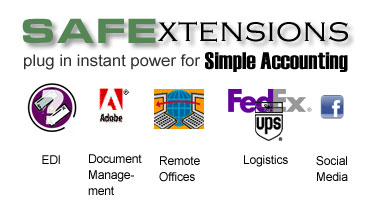You may have used the term account to mean many things, but in this program we use it to mean something very specific and simple: an account is simply a category representing a particular type of business activity such as the amount of sales for a period of time or the amount currently in your bank account. These accounts are traditionally organized in a list called the Chart of Accounts. The chart of accounts is the foundation of any accounting system. Because of this topic’s importance, and because of the wide range of users’ experience with traditional bookkeeping, we must initially spend time reviewing some accounting basics.
Traditionally, accounts are listed in the following order on the chart of accounts:
- Assets
- Liabilities (including Owner’s Capital)
- Revenues
- Expenses
This is done to mirror the look of the balance sheet and the income statement, the two most common financial statements. The top half of the list holds the asset and liability accounts. Comparing the ongoing balance of assets and liabilities at a given point in time is the function of the balance sheet. Balance sheet accounts tend to have perpetual balances, meaning that their balance is carried forward every month, the way the ending balance on your bank statement becomes the beginning balance for the next month. This is a fundamental requirement for making the balance sheet work.
The bottom half of the chart usually consists of revenue and expense accounts. Comparing the balance of revenue and expense categories over a period of time is the purpose of the income statement. Income statement accounts are always reset to zero at the end of a period so that each accounting period reflects the revenues and expenses for that period alone.
Obviously, the order of accounts in the chart in a manual system so that the bookkeeper can easily total the proper accounts at the end of the month or year in order to create financial reports. Following the above system, the bookkeeper can list each account as a row in a spreadsheet and easily total the balance for a range of accounts. But just as important as convenience is the need to organize the presentation of the resulting financial statements so that they present not only accurate, but meaningful and easy to understand information.
To help solve both problems, accounts have traditionally been identified with numbers. This works well for both paper and with machines. A numeric system allows the bookkeeper to indicate the function of the account as well as the position of the account on financial statements. For example, the first digit might be used to indicate the type of account (asset, liability, revenue, expense), while the following digits would then be used to indicate the sub-categories within these major groups. Still more digits could be added to the end of the number to indicate the department or company for this account.
So the account number is used by the bookkeeper (or the computer program) to recognize the horizontal and vertical position of each account on financial statements such as the balance sheet and the income statement. Now with all its advantages, there are some problems with this system:
- You have to remember all the account numbers. This is not trivial for those of us who don’t wish to spend our lives doing bookkeeping.
- If the company decides to change the display of its chart of accounts, it must alter its numbering. This can be a very painful process.
- You might run out of numbers. Seriously, what if your current system uses 401 for Sales Of Stock Forms, 402 for Sales Of Custom Forms and so forth. What happens when your company starts selling Software and you want these to display in between the two of those?
Parents and Child Accounts
Our system addresses each of these problems. Accounts in Simple Accounting are arranged like a family tree. The largest branches of the tree are called parent accounts, while the leaves are referred to as children. Each parent may have many children, but each child account has only one parent.
The parent accounts are used to summarize information. They are the group headings on financial statements so you do not normally enter data into them directly. Rather, you enter transactions into the child accounts. The total of transactions for the child accounts are totalled to their respective parents.
For example, a typical parent account might be called Short Term Assets. Underneath this would typically be several child accounts you use every day such as Accounts Receivable, Petty Cash and Cash In Bank. All three of these working accounts are part of this group, so they would all appear together on your balance sheet and the sum of all three balances would always be totalled to their parent, Short Term Assets:
| 110 | Short Term Assets | |
| 111 | Cash In Bank | 20,500 |
| 112 | Petty Cash | 325 |
| 113 | Accounts Receivable | 72,000 |
| _____ | ||
| Total Short Term Assets | 92,825 |
A parent may also be the child of another account at a still higher level on the family tree:
| 400 | Revenue | |||
| 401 | Sales | |||
| 412 | Custom Forms | 112,325 | ||
| 413 | Stock Forms | 92,000 | ||
| __________ | ||||
| Total | 214,325 | |||
| 444 | Services | 72,500 | ||
| ========== | ||||
| Total | 286,325 |
Notice that that Sales has two children: Custom Forms and Stock Forms. These two accounts form a single group known as Sales. But the Sales account also is itself a child of Revenue and so is a member of the Revenue group along with Services.
RULES FOR ORGANIZING ACCOUNTS
So there is a hierarchy here which follows some simple rules:
- Each account has one parent at a higher level.
- An account takes on the attributes of the account to which it clears.
- A parent of one group may be itself a child of another parent in a higher level group.
By the way, Simple Accounting allows you to have as many groups as you like and the chart of accounts can be as complex as needed. That said, however, we usually recommend simplicity as the best business advice.



